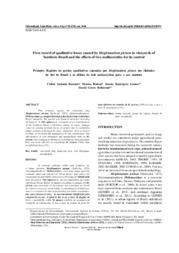First record of qualitative losses caused by Meghimatium pictum in vineyards of Southern Brazil and the effects of two molluscicides for its control.
First record of qualitative losses caused by Meghimatium pictum in vineyards of Southern Brazil and the effects of two molluscicides for its control.
Author(s): BARONIO, C. A.; BOTTON, M.; GOMES, S. R.; ROBINSON, D. G.
Summary: This research reports the terrestrial slug Meghimatium pictum (Stoliczka, 1873) (Stylommathophora: Philomycidae) as an agricultural pest for the fi rst time in Southern Brazil vineyards. The species was found in densities exceeding 20 slugs.m-2 in Vitis labrusca L. vineyards at six municipalities of the Southern Brazil?s viticulture region. It causes damage a loss by leaving residual mucus on grapes and by consuming grapes already perforated by other organisms, such as insects or birds, or mechanically damaged by in situ compression. The effectiveness of iron phosphate and metaldehyde baits on M. pictum was evaluated in laboratory experiments. Iron phosphate bait was more effective in controlling M. pictum (70%) than metaldehyde bait (15%).
Publication year: 2014
Types of publication: Journal article
Unit: Embrapa Grape & Wine
Keywords: Atrativo, Fosfato, Fosfato de ferro, Isca, Lesma, Lesma terrestre, Meghimatium pictum, Praga de planta, Uva, Vinhedo, Viticultura, Vitis labrusca
Observation
Some of Embrapa's publications are published as ePub files. To read them, use or download one of the following free software options to your computer or mobile device. Android: Google Play Books; IOS: iBooks; Windows and Linux: Calibre.
Access other publications
Access the Agricultural Research Database (BDPA) to consult Embrapa's full library collection and records.
Visit Embrapa Bookstore to purchase books and other publications sold by Embrapa.

